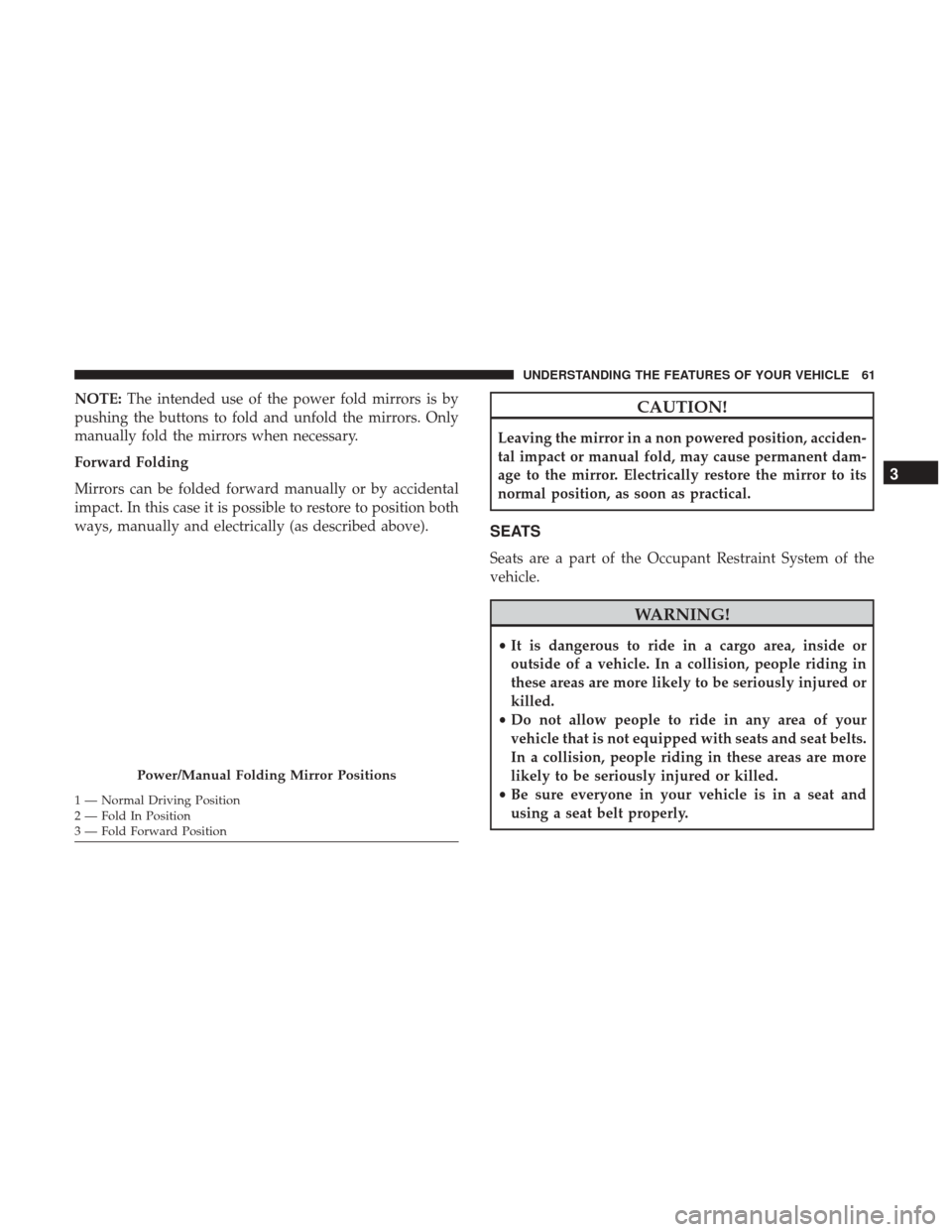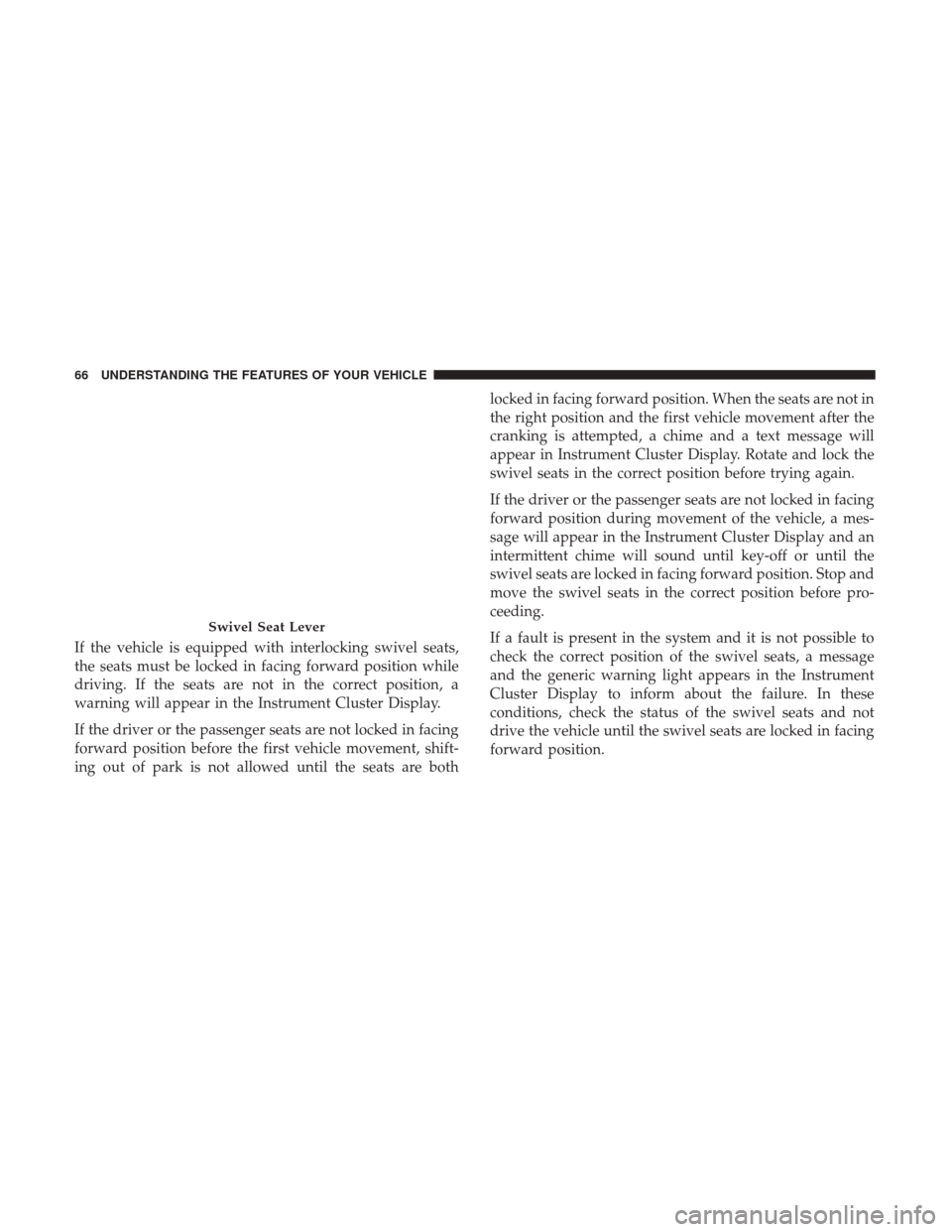Page 60 of 348

MIRRORS
Inside Day/Night Mirror — If Equipped
A two-point pivot system allows for horizontal and vertical
adjustment of the mirror. Adjust the mirror to center on the
view through the rear window.
Headlight glare can be reduced by moving the small
control under the mirror to the night position (toward the
rear of the vehicle). The mirror should be adjusted while
set in the day position (toward the windshield).
Outside Mirrors
To receive maximum benefit, adjust the outside mirror(s) to
center on the adjacent lane of traffic with a slight overlap of
the view obtained on the inside mirror.
WARNING!
Vehicles and other objects seen in an outside convex
mirror will look smaller and farther away than they
really are. Relying too much on side convex mirrors
could cause you to collide with another vehicle or other
object. Use your inside mirror when judging the size or
distance of a vehicle seen in a side convex mirror.
Outside Mirrors Folding Feature
All outside mirrors are hinged and may be moved either
forward or rearward to resist damage. The hinges have
three detent positions:
•Full forward position
• Full rearward position
• Normal position
Manual Rearview Mirror
58 UNDERSTANDING THE FEATURES OF YOUR VEHICLE
Page 63 of 348

NOTE:The intended use of the power fold mirrors is by
pushing the buttons to fold and unfold the mirrors. Only
manually fold the mirrors when necessary.
Forward Folding
Mirrors can be folded forward manually or by accidental
impact. In this case it is possible to restore to position both
ways, manually and electrically (as described above).CAUTION!
Leaving the mirror in a non powered position, acciden-
tal impact or manual fold, may cause permanent dam-
age to the mirror. Electrically restore the mirror to its
normal position, as soon as practical.
SEATS
Seats are a part of the Occupant Restraint System of the
vehicle.
WARNING!
• It is dangerous to ride in a cargo area, inside or
outside of a vehicle. In a collision, people riding in
these areas are more likely to be seriously injured or
killed.
• Do not allow people to ride in any area of your
vehicle that is not equipped with seats and seat belts.
In a collision, people riding in these areas are more
likely to be seriously injured or killed.
• Be sure everyone in your vehicle is in a seat and
using a seat belt properly.
Power/Manual Folding Mirror Positions
1 — Normal Driving Position
2 — Fold In Position
3 — Fold Forward Position
3
UNDERSTANDING THE FEATURES OF YOUR VEHICLE 61
Page 64 of 348

Manual Front Seat Adjustments
The driver and passenger seats can be adjusted forward/
rearward and reclined. Also, if equipped, front and rear
height and lumbar adjustment.
WARNING!
•Adjusting a seat while driving may be dangerous.
Moving a seat while driving could result in loss of
control which could cause a collision and serious
injury or death.
•
Seats should be adjusted before fastening the seat
belts and while the vehicle is parked. Serious injury or
death could result from a poorly adjusted seat belt.
Forward And Rearward Adjustment
The adjusting bar is at the front of the seat, near the floor.
Pull the bar upward to move the seat forward or rearward.
Release the bar once the seat is in the desired position.
Then, using body pressure, move forward and rearward on
the seat to be sure that the seat adjusters have latched. Lumbar Support — If Equipped
This feature allows you to increase or decrease the amount
of lumbar support. The lumbar control knob is located on
the rear upper outboard side of the driver’s seatback.
Rotate the control forward to increase and rearward to
decrease the desired amount of lumbar support.
Drivers Seat
1 — Forward/Rearward Adjusting Bar
2 — Lumbar Knob
62 UNDERSTANDING THE FEATURES OF YOUR VEHICLE
Page 66 of 348

position the seatback as desired. To return the seatback to
its normal upright position, lean forward, rotate the knob
forward until the seatback is in the upright position.
Recliner Adjustment — With Swivel Seat
The recliner lever is located at the lower front outboard
side of the seat. To recline the seatback, lean forward
slightly, pull the lever outward, lean back to the desired
position and release the lever. To return the seatback to its
normal upright position, lean forward and pull the lever
outward. Release the lever once the seatback is in the
upright position.
WARNING!
•Adjusting a seat while the vehicle is moving is
dangerous. The sudden movement of the seat could
cause you to lose control. The seat belt might not be
adjusted properly and you could be injured. Adjust
the seat only while the vehicle is parked.
• Do not ride with the seatback reclined so that the
shoulder belt is no longer resting against your chest.
(Continued)
Recliner Knob
Recliner Lever
64 UNDERSTANDING THE FEATURES OF YOUR VEHICLE
Page 67 of 348

WARNING!(Continued)
In a collision you could slide under the seat belt and
be seriously or even fatally injured. Use the recliner
only when the vehicle is parked.
Suspension Seat — If Equipped
The seat is equipped with a mechanical spring system and
hydraulic shock absorber to ensure maximum comfort and
safety. The system of springs also effectively absorbs im-
pact from uneven road surfaces.
Damper Weight Adjustment
Use the weight adjustment knob to set the required setting
based on body weight, with settings between 88 lbs (40 kg)
and 286 lbs (130 kg).
Swivel Seat — If Equipped
The swivel seat lever is located at the lower front inboard
side of the seat. The seat may be turned through 180°
toward the seat on the opposite side and approximately 35°
toward the door. The seat may be locked in the driving
position or at the 180° position. To swivel the seat, pull the
swivel seat inboard lever outward, turn the seat to the
desired position and release the lever.
Weight Adjustment Knob
3
UNDERSTANDING THE FEATURES OF YOUR VEHICLE 65
Page 68 of 348

If the vehicle is equipped with interlocking swivel seats,
the seats must be locked in facing forward position while
driving. If the seats are not in the correct position, a
warning will appear in the Instrument Cluster Display.
If the driver or the passenger seats are not locked in facing
forward position before the first vehicle movement, shift-
ing out of park is not allowed until the seats are bothlocked in facing forward position. When the seats are not in
the right position and the first vehicle movement after the
cranking is attempted, a chime and a text message will
appear in Instrument Cluster Display. Rotate and lock the
swivel seats in the correct position before trying again.
If the driver or the passenger seats are not locked in facing
forward position during movement of the vehicle, a mes-
sage will appear in the Instrument Cluster Display and an
intermittent chime will sound until key-off or until the
swivel seats are locked in facing forward position. Stop and
move the swivel seats in the correct position before pro-
ceeding.
If a fault is present in the system and it is not possible to
check the correct position of the swivel seats, a message
and the generic warning light appears in the Instrument
Cluster Display to inform about the failure. In these
conditions, check the status of the swivel seats and not
drive the vehicle until the swivel seats are locked in facing
forward position.
Swivel Seat Lever
66 UNDERSTANDING THE FEATURES OF YOUR VEHICLE
Page 71 of 348

WARNING!
•Persons who are unable to feel pain to the skin
because of advanced age, chronic illness, diabetes,
spinal cord injury, medication, alcohol use, exhaus-
tion or other physical condition must exercise care
when using the seat heater. It may cause burns even
at low temperatures, especially if used for long
periods of time.
• Do not place anything on the seat or seatback that
insulates against heat, such as a blanket or cushion.
This may cause the seat heater to overheat. Sitting in
a seat that has been overheated could cause serious
burns due to the increased surface temperature of the
seat.
Head Restraints
Head restraints are designed to reduce the risk of injury by
restricting head movement in the event of a rear impact.
Head restraints should be adjusted so that the top of the
head restraint is located above the top of your ear.
WARNING!
The head restraints for all occupants must be properly
installed and adjusted prior to operating the vehicle or
occupying a seat. Head restraints should never be
adjusted while the vehicle is in motion. Driving a
vehicle with the head restraints improperly adjusted or
removed could cause serious injury or death in the
event of a collision.
3
UNDERSTANDING THE FEATURES OF YOUR VEHICLE 69
Page 72 of 348
Front Head Restraints
To raise the head restraint, pull upward on the head
restraint. To lower the head restraint, push the adjustment
button located on the base of the head restraint and push
downward on the head restraint.
To remove the head restraint, raise it up as far as it can go
then push the adjustment button and the release button at
the base of each post while pulling the head restraint up. To
reinstall the head restraint, put the head restraint posts into
the holes then adjust it to the appropriate height.
WARNING!
•A loose head restraint thrown forward in a collision
or hard stop could cause serious injury or death to
occupants of the vehicle. Always securely stow re-
moved head restraints in a location outside the
occupant compartment.
(Continued)
Adjustment Buttons
1 — Release Button
2 — Adjustment Button
70 UNDERSTANDING THE FEATURES OF YOUR VEHICLE